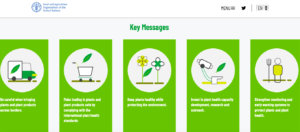The designation of an international year means that the United Nations member states have agreed the issue is important to the world. https://www.un.org/en/sections/observances/international-years/index.html
What does that mean for me?
Over the course of 2020, I will be writing a series of blogs that touch on the international guidance, regulations and ongoing research in plant health, but from angles that are relevant to everyday living from my perspective.
People pick up messages in different ways and few are willing to wade through a lot of text, so these blogs will be brief and with photos and links. I also know that any essential information needs to be reiterated frequently, so key messages will be repeated!
Let’s start then with a brief interpretation of the Food and Agriculture Organisation of the United Nations’s 5 key messages http://www.fao.org/plant-health-2020/about/en/
- Be careful when bringing plants and plant products across borders.

That means for example, realising that the apple in your lunchbox that you forget to eat and throw away on your holiday abroad could spread disease. Likewise the fresh flowers you might be tempted to buy as a present at the airport could bring in insects or other disease. - Make trading in plants and plant products safe by complying with the international plant health standards. Plants and plant products can carry pests and disease that can easily spread to plants in our gardens, farms and forests. The most practical way to keep diseases out of the country is to ensure plants and plant products are pest and disease free at our borders by standards and regulation (more on this in a future blog).
 That means pallets for wood packing too. I recently had a delivery on a wood pallet, so I looked for the ISPM15 stamp. If it’s not there, it could be harbouring insects that carry plant disease and should be burned. For more information on wood packaging materials see module 3 (of 5 free training modules) https://planthealthy.org.uk/assets/downloads/Module-3_Plant-Healthy_Pathways-of-Introduction-and-Spread_V1.1.pdf
That means pallets for wood packing too. I recently had a delivery on a wood pallet, so I looked for the ISPM15 stamp. If it’s not there, it could be harbouring insects that carry plant disease and should be burned. For more information on wood packaging materials see module 3 (of 5 free training modules) https://planthealthy.org.uk/assets/downloads/Module-3_Plant-Healthy_Pathways-of-Introduction-and-Spread_V1.1.pdf - Keep plants healthy while protecting the environment. We can’t keep every plant disease-free; this is one of the interesting differences between plants and animals (this could be a whole Biology class lecture if you’re interested). Instead, we have to understand when some biological interactions get out of control. Can’t we spray with pesticides you say? Sometimes we can, but this causes its own problems too. Getting the balance right between when and when not to use pesticides is an area currently under extensive debate.
- Invest in plant health capacity development, research and outreach. In short, we won’t find the solutions to the plant health global challenges unless we do this, and research takes a long time to do it properly, so we need to be investing now. Fortunately, we have a strong base in this science already but it needs continued support. What does outreach mean? It means explaining why this is important to people as I am doing now.
- Strengthen monitoring and early warning systems to protect plants and plant health. Fortunately, there is some amazing science being done to monitor plant health and track how diseases spread across the world. As with human epidemics, being forewarned is to be forearmed e.g. protecting people from flu by vaccinating more people.
I said these blogs would be brief, so that’s it for this one but I will be providing more links and references in future blogs. Plant health is complex but relevant to every one of us. If you find something here that strikes a chord with you, why not have a conversation with someone you know about it. We’ve got all of 2020 to keep talking about plant health. Feel free to message me too.


Comments 4
Pingback: International Year of Plant Health - January 2020 - Celia Knight Consulting
Pingback: International Year of Plant Health - February 2020 - Celia Knight Consulting
Pingback: International Year of Plant Health - March 2020 - Celia Knight Consulting
Pingback: International Year of Plant Health - April 2020 - Celia Knight Consulting